Here’s my Sprout Valley review. I was not provided a review code for this game.
Sprout Valley is a small, cozy farming and life sim for Steam and the Nintendo Switch. You’ll play as anthropomorphic cat named Nico, who recently left big city life to try his hand at rural living. Pick an island, build your garden, and explore the world on your little wooden boat.
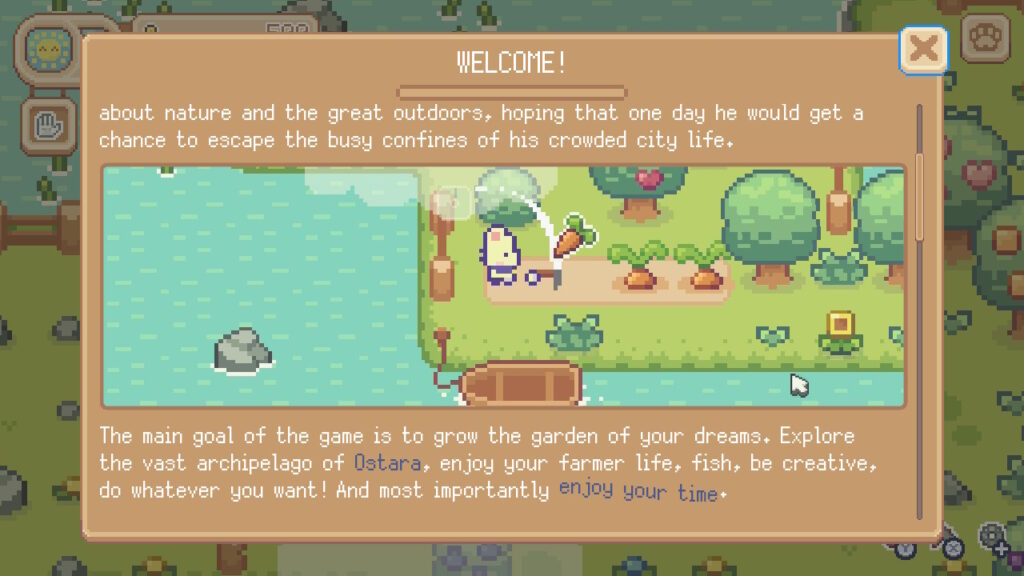
First Impressions
Sprout Valley charmed me with its graphics and style. It felt like the developer understood the cozy aesthetic and leaned into it in just the right ways. The animal cast and calm, meandering narrative was lightly reminiscent of the Animal Crossing franchise.
Once you start to play, Sprout Valley lurches and jolts; a clumsy start made even messier by non-intuitive gaming controls. “B” as your dialogue progression button, for example, and D-pad to scroll down certain menus. And I saw online that I wasn’t the only one who couldn’t figure out how to “activate” the bag expansion once it arrived. You can adjust controls in the menu later but nothing felt good right off the bat.
The opening tutorial is a wall of text, additional “hints” pop up out of the blue and disrupt your day 1 actions. There are no immediate goals or quests to help you guide your learning. You need to “find” your starting tools by wandering around your home island (odd), which is a tiny plot of land maybe 15-20 squares down and across. It is also messily laid out, with trees, your cabin, a well, and bushes cutting into your precious farming space.
Not to mention that there didn’t seem to be any motivation to do anything. No gameplay “loop” right off the bat. Just do the thing, level up. But it left me wondering: why? I tried to build a bridge to another island I could barely glimpse in the periphery of the screen—it took me days to arrive and it was no more than 5X2 squares, with a single bush and a pebble.
On day 12 you get a hint of the potential story to come, but even that is delivered frustratingly. Out of stamina, I was forced to stand outside and wait for nightfall so a certain event would trigger. I couldn’t sleep to pass the day, I couldn’t get on my boat to forage on other islands, every task on my home lot was done. So I just…stood there.
It was a full 23 in-game days before the game established a greater purpose for what I was doing. But finally, finally I had an inkling of how to spend my time and what the overarching goal was. It was time to find out if the wait was worth it.
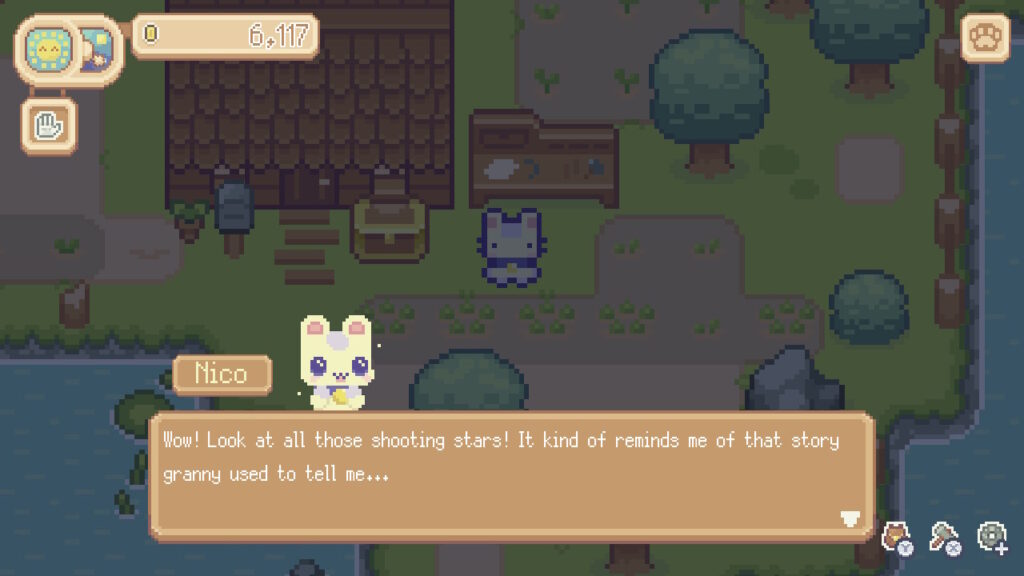
Characters & Story
Unfortunately, the game doesn’t offer much in the way of characters and story. The cast is Nico, the main character; the spirit of a mouse in the basement named Luna; and the merchant who buys your produce and sells you assorted items, called Ozlo. You can collect pets that follow you around and will occasionally see a silent shopkeeper standing behind a booth on some of the random islands. That’s it. There is no village or town to visit, no neighbors to get to know, and no one to talk to except Luna.
The story is simplistic and a bit random. Nico loves Star Fruits and wants to find a way to share them with the world. To help him do this, Luna finds the skeleton of a machine and some instructions for how to make it whole again. The machine will process a single Star Fruit into a bunch of seeds, which Nico can then share with his friends back home. That’s all there is to it. There are no NPC storylines or side quests. There isn’t really much in the way of world lore, either.
Sprout Valley is bare bones, that’s for sure. I would say it’s a little overpriced for what you get, too. It would be a great $5.00 mobile game, in my opinion.
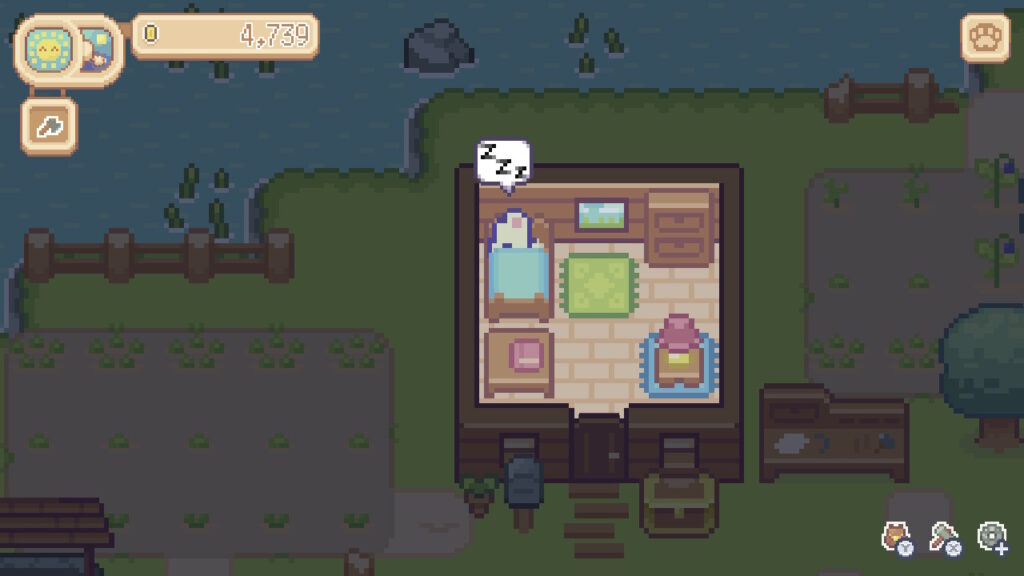
Gameplay Loop
The gameplay path of Sprout Valley will be familiar to farming sim fans. You have your tool belt (axe, pickaxe, watering can, gardening hoe, fishing pole) and you spend your days performing associated actions: chopping trees, mining rocks, tending your garden, and fishing. You can also travel from island to island and forage various fruits and supplies.
You are totally isolated in the game except for a walkie-talkie connection with Ozlo and Luna hanging out in the basement. It’s exceedingly lonely in a way the world doesn’t address in any meaningful way. Why am I living alone on a tiny plot of land out at sea?
As mentioned above, the homestead area is very small. There is not a lot to do if you don’t set sail. Traveling to another island requires an item called Travel Supplies that cost 250 in-game gold and takes overnight to arrive in your inventory. With minimum stamina and a punishingly small inventory, it just wasn’t worth it to try to explore much in the first few weeks.
Honestly, a big part of my heart loves to just…meander in these types of cozy games. I can fill 99% of my time with self-imposed tasks and sink deep into the Zen of it all. So I was open to a minimalist game like Sprout Valley “working” as a concept. But everything was too…small. Small landscape, small cast, small purpose. I just needed one or two more landmarks to ground what I was doing. A few more characters to talk to. Or free reign to explore other islands without paying a toll.
I tried to be entrepreneurial and start making money, even if I didn’t know how I would spend it all. That’s when the game started to click for me a bit. Despite progression being slow as molasses, the basic mechanics are satisfying when stacked together in a bustling, productive day. I would wake up, water my plants, chop wood, mine rocks, and then visit an island and forage until my pack was full. On rainy days I might fish instead of explore, but that was the gist of it. Then I would sell my valuables, store my crafting supplies, and start the next day.
Yes, the gameplay loop has an uber-cozy march to it all—but it also gets old fast. Eventually, you will be asked to collect a certain number of items to progress the story. There is a lot to collect, numerically speaking, but there is zero variety. I spent days collecting hundreds of lumber, rocks, and weeds, and even more so crafting the same two or three recipes for ingots, planks, and sticks. At its best, Sprout Valley might ask you to grow and harvest 30 pumpkins for one of the requirements. At its worst, you might need to collect 200 pieces of wood (multiple times, I might add) or 100 Magic Dust (produced as a byproduct of crafting).
There are 9 “buckets” of materials you need to fill for the main story quest. (Think: like the Stardew Valley community center.) But each bucket will ask for duplicate items. So you may need 60 wood for one bundle and then 200 wood for another. Obviously, this gets dull after a while. The collection requirements don’t even include common foraging items (strawberries, blueberries) or fish at all.
Once all the bundles are complete, the game is over. Nico uses all the materials to build his machine, which is essentially a giant seed maker. And before you can even run over to collect your long awaited spoils, the credits roll. Sprout Valley is a very small, minimalist experience that will leave most players hungry for something more.
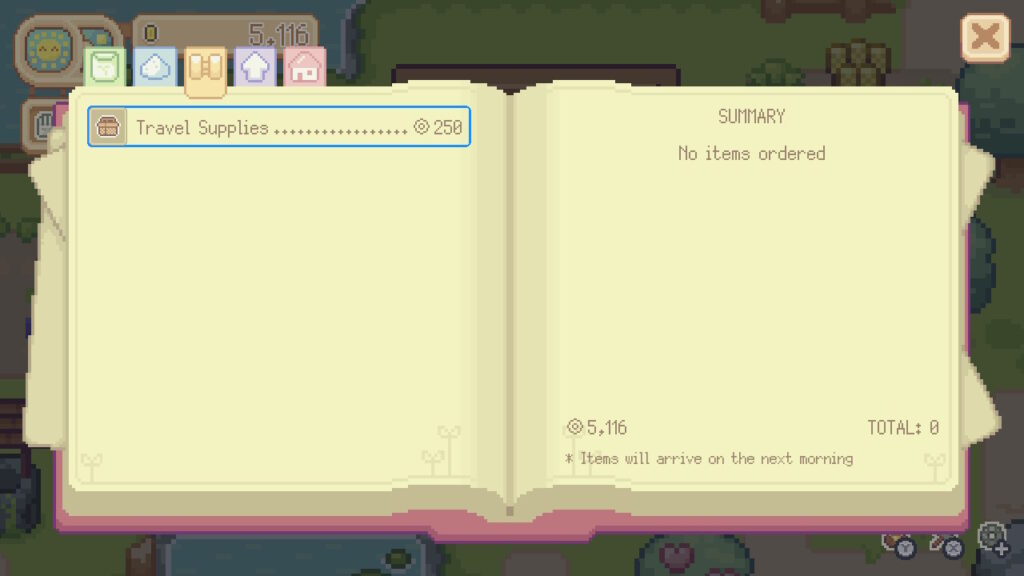
Technical Issues
Sprout Valley is a small, well-built game technically-speaking. Here are the only issues I encountered while playing it on Nintendo Switch, none of which were game-breaking.
- Due to procedural generation, the islands you visit can actually block you from entering with an ill-placed bush or rock; this wastes your Travel Supplies for that trip
- Menus for shops appear by pressing up against a trigger, which raises the window; if you hit “A” (a very common impulse) you will automatically buy the first item on the list
- The pathway in front of the ladder to the basement is cluttered with machine pipes, mis-maneuvering around them can cause you to bump the trigger to go back up to the surface, which can cause frustration
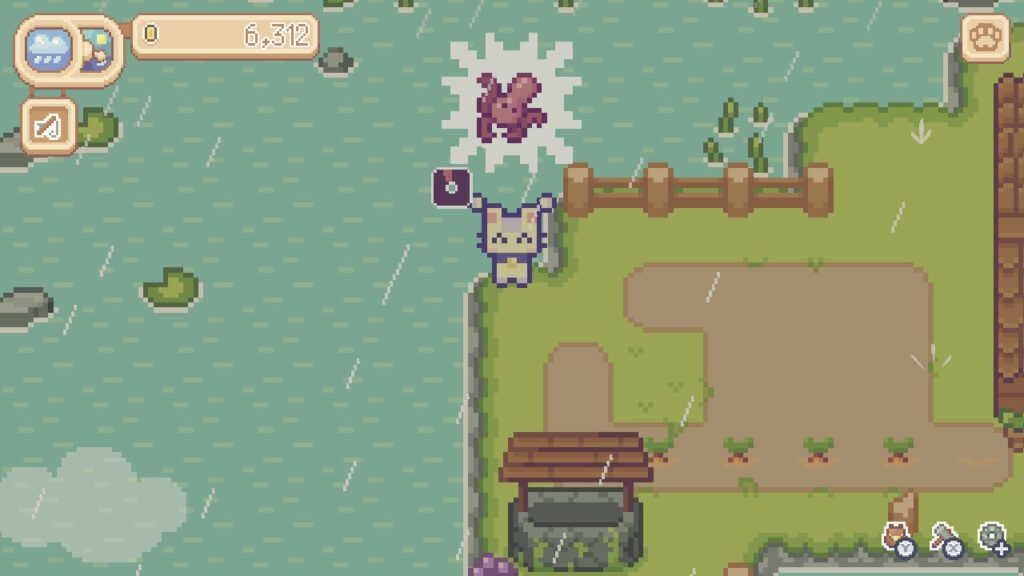
Summary
Here is the TLDR if you don’t have time to read my full Sprout Valley review.
Pros
- Cute pixel graphics
- Decent farming & crafting loop
Cons
- Repetitive gameplay
- Empty world
- Very short
Conclusion
Sprout Valley is a short, minimalist farming sim that isn’t priced competitively enough for what you get from it. Everything is small: the cast, the story, the world. I fear most players will feel claustrophobic locked on their little island, toiling away at growing 80 corn and 80 eggplants in a world where the seasons don’t even change. Sprout Valley feels like the product of a Game Jam; the concept is there, it just needs to be fleshed out. If you enter the game imagining it as closer to a cozy mobile experience, you might have a better time of It.
I would recommend buying Sprout Valley at a steep discount if you want to try it out. Wishlist it and try waiting for a sale of 50% or more.
Who Sprout Valley is for:
- Fans of simplistic, short experiences
- Fans of cute pixel pastel aesthetics
Who Sprout Valley is not for:
- Players who want an interesting, interactive cast of characters
- Players who get bored by repetition
- Players who feel short games are not worth the money
Stay cozy, gamers!
